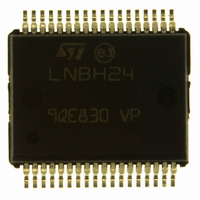LNBH24PPR STMicroelectronics, LNBH24PPR Datasheet - Page 6

LNBH24PPR
Manufacturer Part Number
LNBH24PPR
Description
IC LNB SUPPLY/CTRL DUAL PWRSSO36
Manufacturer
STMicroelectronics
Datasheet
1.LNBH24PPR.pdf
(30 pages)
Specifications of LNBH24PPR
Applications
Converter, Analog and Digital Satellite STB Receivers/SatTV
Voltage - Input
8 ~ 15 V
Number Of Outputs
2
Voltage - Output
13.4V, 18.5V
Operating Temperature
0°C ~ 85°C
Mounting Type
Surface Mount
Package / Case
PowerSO-36 Exposed Bottom Pad
Output Voltage
19.5 V
Output Current
750 mA
Input Voltage
8 V to 15 V
Switching Frequency
220 KHz
Operating Temperature Range
- 25 C to + 125 C
Mounting Style
SMD/SMT
For Use With
497-8718 - DEMO BOARD BASED ON LNBH24LNBH24DEMOBOARD - DEMO BOARD FOR LNBH24
Lead Free Status / RoHS Status
Lead free / RoHS Compliant
Other names
497-6882-2
LNBH24PPR
LNBH24PPR
Available stocks
Company
Part Number
Manufacturer
Quantity
Price
Company:
Part Number:
LNBH24PPR
Manufacturer:
STMicroelectronics
Quantity:
1 000
Part Number:
LNBH24PPR
Manufacturer:
ST
Quantity:
20 000
2.5
Figure 2.
2.6
2.7
6/30
be activated both with the DSQIN pin or the TEN I²C bit. The DSQIN internal circuit activates
the 22 kHz tone on the V
presence on the DSQIN pin, and it stops with 1 cycle ± 25 µs delay after the TTL signal is
expired.
Data encoding through external tone generator (EXTM)
In order to improve design flexibility an external tone input pin is available (EXTM). The
EXTM is a Logic input pin which activates the 22 kHz tone output, on the V
the LNBH24 integrated tone generator (similar to the DSQIN pin function). In fact, the output
tone waveform characteristics will always be internally controlled by the LNBH24 tone
generator and the EXTM signal will be used as a timing control for DiSEqC tone data
encoding on the V
control of the EXTM pin function. Before sending the TTL signal on the EXTM pin, the V
tone generator must be previously enabled through the TTX function (TTX pin or TTX bit set
HIGH). As soon as the EXTM internal circuit detects the 22 kHz TTL signal code, it activates
the 22 kHz tone on the V
presence on the EXTM pin, and it stops with 2 cycles ± 25 µs delay after the TTL signal is
expired (see
EXTM timings
I²C interface
The main functions of the IC are controlled via I²C BUS by writing 8 bits on the system
register (SR 8 bits in write mode). On the same register there are 8 bits that can be read
back (SR 8 bits in read mode) to provide 8 diagnostic functions: five bits will report the
diagnostic status of five internal monitoring functions (IMON, VMON, TMON, OTF, OLF),
while three will report the last output voltage register status (EN, VSEL, LLC) received by
the IC (see the diagnostic functions section). Each section (A/B) has two selectable I²C
addresses selectable, respectively, through the ADDR-A and ADDR-B pins (see address
pins characteristics
Output voltage selection
When the IC sections are in standby mode (EN bit LOW), the power blocks are disabled.
When the regulator blocks are active (EN bit HIGH), the output can be logic controlled to be
13 or 18 V by means of the VSEL bit (Voltage SELect) for remote controlling of non-DiSEqC
LNBs. Additionally, the LNBH24 is provided with the LLC I²C bit which increase the selected
voltage value by +1 V to compensate the excess of voltage drop along the coaxial cable.
Figure
oTX
Table
2).
output. A TTL-compatible 22 kHz signal is required for the proper
oTX
oTX
10).
output with 0.5 cycle ± 25 µs delay from the TTL signal
output with 1.5 cycles ± 25 µs delay from the TTL signal
oTX
pin, by using
oTX













